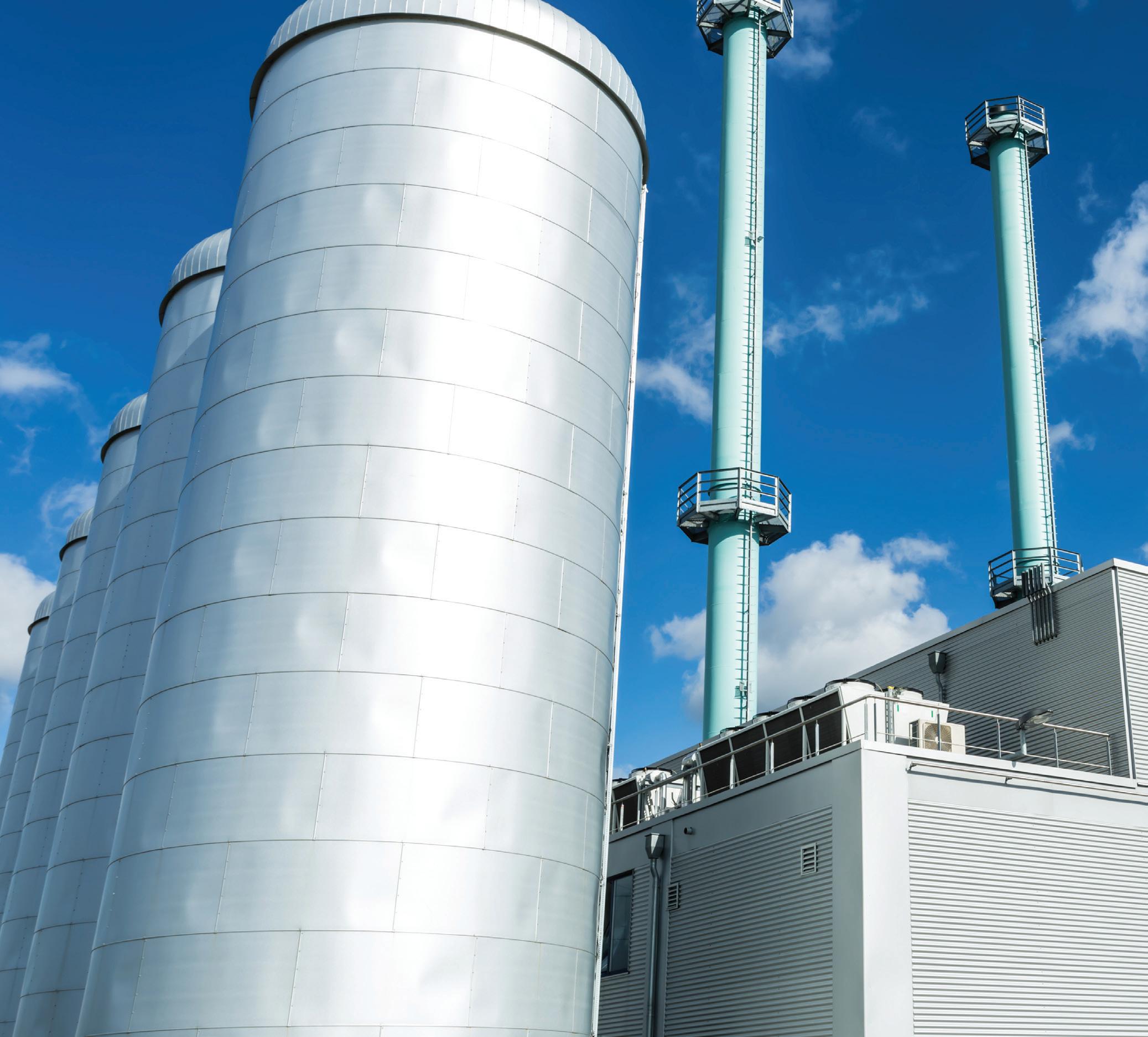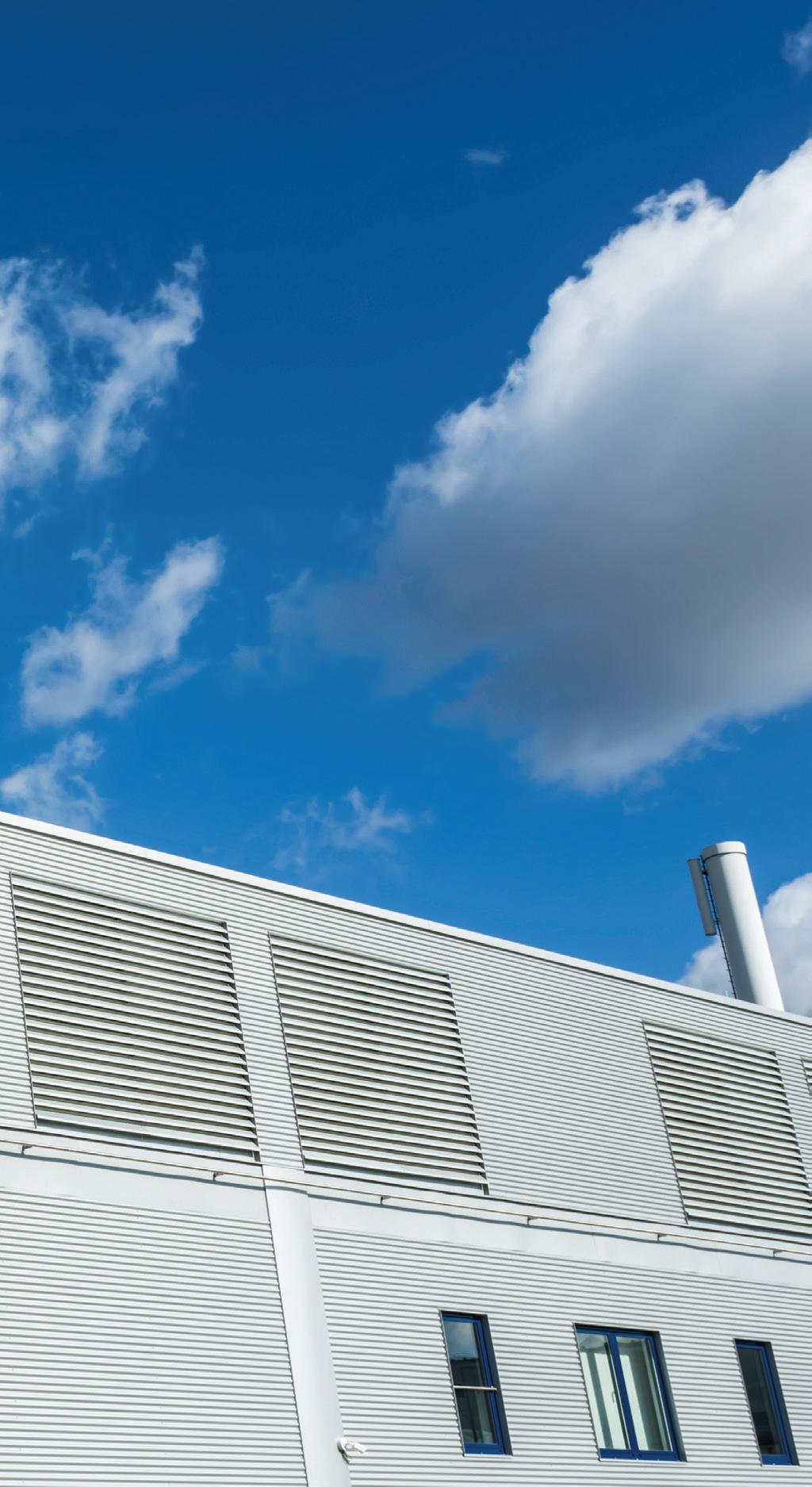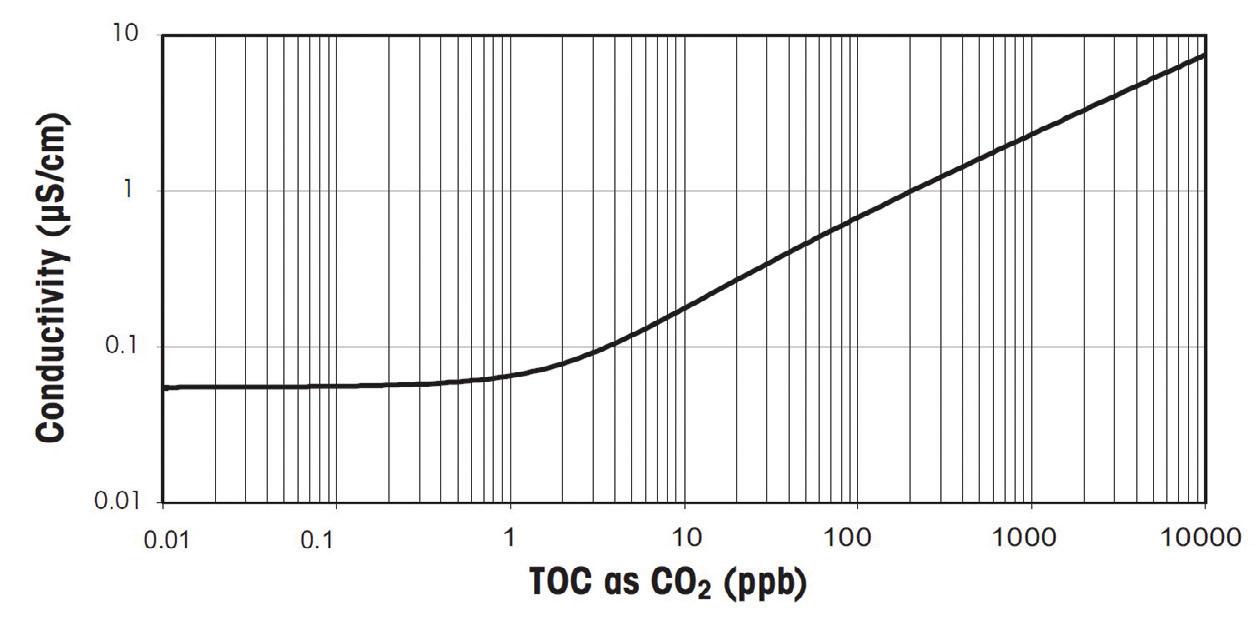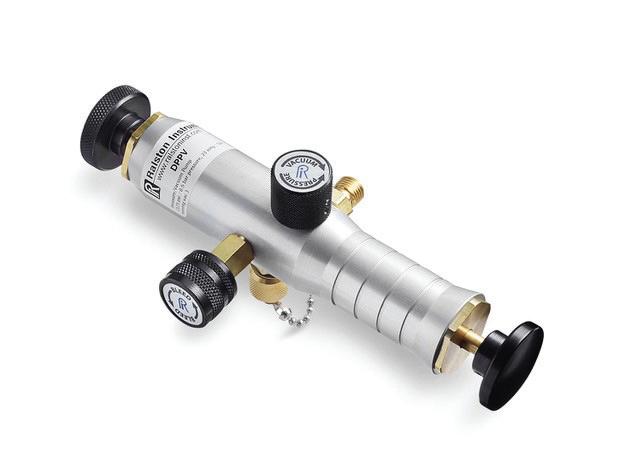
12 minute read
Detecting organic contamination in cogeneration water
DETECTING ORGANIC CONTAMINATION IN COGENERATION
WATER Effective TOC measurement is necessary if organics are present in cogeneration process water.
While most efforts at producing pure water are aimed at removing minerals, these purifying processes do not necessarily remove organic compounds. There is an increasing awareness of the operational risks and damage that organics can cause in power generation equipment and this is driving changes in water treatment methods. Controlling organics is especially critical in cogeneration power/steam cycles, where the purified condensate water returning from production processes is subject to organic contamination. Key to confirming and troubleshooting organics removal is reliable online total organic carbon (TOC) measurement.
Effects of organics
Organic contamination of pure power plant waters can cause a number of costly problems, including fouling of resins in make-up and condensate deionisers that requires frequent resin cleaning and replacement; breakdown of organics to acids that lower the pH of condensate and cause boiler and turbine corrosion; deposition onto heat exchange surfaces leading to significantly reduced efficiency; and foaming in the boiler that can increase carryover of other contaminants into the steam. The occurrence of any of these problems can be a major concern in plants.
Sources
In the power/steam cogeneration cycle, steam is generated to drive turbines to produce electricity. It is then diverted to production processes to provide heat before being condensed and circulated back to the boilers to be reused in power generation. It is the purified condensate water returning from the production processes that is most likely to be subject to organic contamination from leaks while the steam is being used for heat.
Depending on the production process, organic contamination may exceed acceptable limits and disrupt the cogeneration cycle. The treatment system to remove such contamination needs to be carefully designed to ensure it can withstand any organics spikes caused by plant disturbances or in-leakage events.
The second most significant source of organics is make-up water. Surface waters have higher levels of naturally occurring organics than groundwaters. But groundwater sources are being depleted in many areas. As a result, there is greater reliance on
iStock.com/querbeet; Water
DEPENDING ON THE PRODUCTION PROCESS, ORGANIC CONTAMINATION MAY EXCEED ACCEPTABLE LIMITS AND
DISRUPT THE COGENERATION CYCLE.
surface water, reclaimed water and even municipal wastewater as the raw source for high purity make-up water for the water/ steam cycle. A further complication is that surface water sources typically have substantial seasonal variations in concentration and types of organics. A treatment system that uses source water with low organics during one season may be seriously challenged in another season. Even greater changes in source water composition can strain a treatment system if it must alternate between surface water high in organics during wet seasons and groundwater high in minerals in dry periods.
Another source of organics is ion exchange resins in the treatment system as the beads themselves are composed of organic polymers. Resin fines from physical breakdown of the beads can find their way into the steam cycle if they are not fully trapped. Chemical breakdown of resins produces trace contaminants: sulfonic acids from cation resins and amines from anion resins. In addition, traces of processing solvents may also be released. These contaminants may include inorganic constituents in their structure such as chloride and sulfate that are released in the steam cycle through thermal degradation and become even more corrosive.
Additional sources of organic contamination are present directly in the steam cycle, including pump lubricants, condenser leaks and condensate polishing resins. Organic cycle chemistry additives, where used, represent a further potential source that must be compatible with the overall cycle and closely monitored to prevent unintended negative consequences.

TOC measurement technology
Condensate purity is normally monitored by conductivity measurements, with resistivity measurements becoming effective earlywarning systems1. The effectiveness of resistivity measurements is due in part to its sensitivity at ppb levels2. However, as discussed, organic compounds from production processes may contaminate the condensate. These organics are generally non-conductive and therefore cannot be detected via conductivity measurement. For detection of these organics, they must be converted to a form that produces conductive species in pure water. In TOC measurements, organics are oxidised and produce carbonic acid (a conductive species). The conductivity of the carbonic acid generated is then measured and correlated to the amount of organic contamination present in the water.
Oxidation
The primary means of oxidation is the use of ultraviolet (UV) radiation at 185 nm and 254 nm. It is impossible to describe the detailed photo-oxidation mechanism of every conceivable organic oxidation reaction and, in many cases, it is not clearly known at the molecular level. Regardless of the organics involved, the end result is normally a reaction that can be summarised in the following equation:
Cx H y O z + [O] + UV xCO2 + H2O Eq (1)
where C x
Hy
Oz is the organic contaminant and [O] is an oxidation source, usually oxygen or persulfate.
The oxidation of the organic carbon to carbon dioxide (CO2) results in the formation of dissolved CO2 in water. This leads to the formation of an unstable intermediate, carbonic acid (H2CO3), which is a weak acid and partially dissociates to ionic species.
CO2 + H2O (H2CO3) H+ + HCO3

Figure 1: The relationship between conductivity and carbon concentration.
The extent of the formation of ionic species is controlled by physical-chemical equilibria3 and is described according to Eq (3).
K1 = ([H+] [HCO3 -])/[CO2]aq = 4.45 x 10-7 at 25°C Eq (3)
Detection
The strategic reason to form CO2 is based not just on the relative ease of oxidising organic contaminants, but on its detectability and quantification by various analytical methods, including conductivity. When ionic species are present in pure water, conductivity represents the most sensitive real-time means of detection. The reaction products described in Eq (2) are not only detectable by conductivity, they are also optimised for detection due to the formation of highly conductive H+. Figure 1 shows the relationship between conductivity and concentration of carbon (as CO2) at 25°C.
Based on Eq (3), known chemical equations for conductivity and the chemical equilibria for this system, the amount of carbon can be determined. This is usually expressed in ‘ppb’ (µg/L).
Typical TOC measurement in cogeneration
As an example of cogeneration processes where TOC monitoring is crucial, Figure 2 outlines a basic layout of a raw sugar production process. A similar need for TOC monitoring is also evident in cogeneration cycles in other production processes.
During raw sugar production the juice from the sugar cane is heated using steam to remove excess water. The condensed steam from the evaporation process is then fed into a series of boilers to regenerate pure steam in the boiler house. If organics contaminate the condensate during the evaporation process, this can be catastrophic to the power generation cycle. In the boilers, the organics can be deposited onto heat exchange surfaces, which significantly reduces their efficiency.
Organics can also cause foaming and carryover of other contaminants into the steam which can corrode expensive turbines. When organics are present in the condensate and are exposed to elevated temperatures in the boilers, partial thermal degradation and oxidation of the organic contaminants occurs. This process produces organic acids that can lower pH and lead to additional corrosion and inefficiencies in power generation. Early quality control of the initial condensate produced from the evaporation process by measurement of key parameters such as total organic carbon (TOC), pH and conductivity guards against contamination, subsequent deposits and corrosion.
Cogeneration plant records of conductivity and TOC measurement have shown that organic and inorganic contamination do not always coincide. It is possible for the water to be contaminated with organic compounds without being contaminated with conductive substances. Therefore, online TOC measurement is a key monitoring parameter to protect power generation equipment.
TOC sensor design
To ensure that TOC contamination is quickly detected and measures are taken to control it, it is highly beneficial to have a TOC sensor that continually monitors and rapidly responds to changing levels of contamination. It should also offer features that constantly provide diagnostics of the sensor’s performance, to ensure that the measurement is reliable and accurate while also providing notice to the user regarding the need for maintenance.
Figure 3 shows a simplified layout of a typical TOC sensor, with oxidation and detection processes outlined.
The fastest responding instruments using this technique have a high-intensity UV lamp with a continuously flowing sample through the sensor. Such designs operate without any moving parts, membranes or chemicals, which increases reliability and reduces running costs.
The conductivity measured at Sensor 1 is background conductivity due to dissolved carbon dioxide and any minerals already present in the water. The change in conductivity measured by Sensor 2 is due to any organics that were oxidised by the UV lamp and converted into carbonic acid.
If the temperature of the condensate is too high, a sample conditioning coil may be placed at the sensor inlet to reduce the temperature to near ambient conditions. Where particulates are present, sample filtration may also be required.
This technology does have application limitations. It is used only on pure water samples with conductivity around 2 µS/cm and TOC of 0.05 to 2000 ppb. However, conductivity can easily be kept within range with the use of a cation resin column: the same

Figure 2: The raw sugar production process.

Figure 3: Flow path of a direct conductivity TOC sensor.
type of column that is commonly used in water sample panels to measure cation conductivity.
Conclusion
Considering that organic contamination is capable of causing process disruptions as well as damage to expensive capital equipment, it is essential to continuously measure TOC in the cogeneration cycle. TOC monitoring and control will not only ensure effective operation of the cycle, but also avoid any unplanned shutdown of production processes due to disruption in steam/heat. To effectively implement such monitoring, online measurement of TOC is critical in obtaining a real-time assessment of water/steam quality. With online measurements being increasingly used for decision-making, instrument capabilities and performance must be commensurate with this responsibility.
1. Morash KR, Thornton RD, Saunders CH, Bevilacqua AC, Light TS 1994, “Measurement of the Resistivity of High-Purity Water at Elevated Temperatures”,
Ultrapure Water, December 1994. 2. Bevilacqua AC 1998, “Ultrapure Water - The Standard for Resistivity Measurements of Ultrapure Water”, 17th Annual Semiconductor Pure Water and
Chemicals Conference, 2-5 March1998. 3. Light TS, Kingman B, Bevilacqua AC 1995, “The Conductivity of Low Concentrations of CO2 Dissolved in Ultrapure Water from 0-100°C”, 209th American
Chemical Society National Meeting, 2-6 April 1995.
FAST RFID I/O MODULE FOR ETHERCAT

Turck has added the TBEC series to its range of RFID solutions to enable a fast interface with EtherCAT networks. The TBEC module has a fully potted plastic housing, is rated at IP67/IP69K and is suitable for temperature ranges from -40 to +70°C. The EtherCAT RFID module can run high-frequency (HF) and ultrahigh-frequency (UHF) read/write heads at the same time, thus simplifying applications with different bandwidths and reducing the range of inventory needed. It supports RFID applications with frequent, fast-moving tags and up to 128 read/write heads.
The product also supports the HF continuous bus mode, allowing up to 32 bus-capable HF read/write heads to be connected to each of the four RFID channels. In applications with many write or read positions, this should reduce wiring effort, costs and commissioning times. Sensors, lights or other actuators can be connected to the eight universal input or outputs. All I/O ports are 5-pin M12 male connectors, and the power connectors use futureproof L-coded M12 power technology.
Due to the integrated RFID U data interface with cyclical process data transmission, the user benefits from fast and easy access to HF and UHF functions such as Idle mode. The EtherCAT module is thus suitable for use in RFID applications where tags must be read in rapid succession, such as identifying hanging goods in materials handling applications.
Turck Australia Pty Ltd
www.turck.com.au
CALIBRATION TEST PUMPS
Ralston Instruments offers a range of pneumatic pressure/vacuum calibration test pumps designed to generate low pressure up to 125 psi or draw a vacuum to -15 psi for calibrating low pressure or vacuum instrumentation. A simple direct-acting pump action with fine adjustment piston is designed to give users precise control, even at very low pressures. The pump bodies are made from anodised aluminium so they’re lightweight and portable, won’t rust or corrode, and can easily handle sand, sticks or other contaminants in the field.
Three options are available — the DP0V pneumatic pressure pump, the DV0V pneumatic vacuum pump and the DPPV pneumatic pressure/vacuum pump that lets users switch from pressure to vacuum with the twist of a knob.
An economical choice for measuring differential pressure on pipelines and other vital industrial process systems, they are suitable for performing the low-side calibration of pressure transmitters or pressure switches for clean rooms, HVAC and similar applications.
Ralston Instruments LLC
www.ralstoninst.com

DELTA ROBOT FOR LIGHT WORK
ABB has expanded its FlexPicker Delta robot range with the IRB 365, which it claims is the fastest in its class for reorientating packaged lightweight products such as cookies, chocolates, candies, small bottles and parcels.
Responding to the rise in ecommerce and growing demand for shelf ready-packaged goods, the IRB 365 has been developed for applications including food and beverage, pharmaceuticals and consumer goods, where production line speed and adaptability are essential. The IRB 365 can pick, reorientate and place 1 kg products at 120 picks/min.
From product reorienting, toploading and secondary packaging, to bottle handling, unscrambling, 3D picking, feeding and parcel sorting, the IRB 365 is designed to meet a wide variety of applications. Powered by the OmniCoreTM C30 controller, the system offers built-in digital connectivity and more than 1000 additional software/hardware functions ready to meet future demands and requirements.
Through ABB’s PickMaster Twin software, the IRB 365 can be integrated into packaging lines in a matter of hours rather than days, using digital twin technology, which also reduces changeover times.
ABB Australia Pty Ltd
www.abbaustralia.com.au



